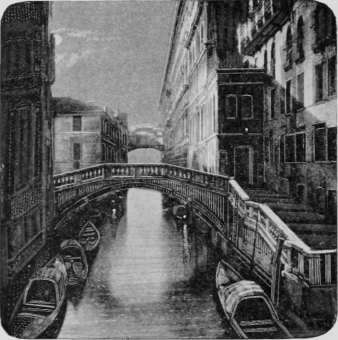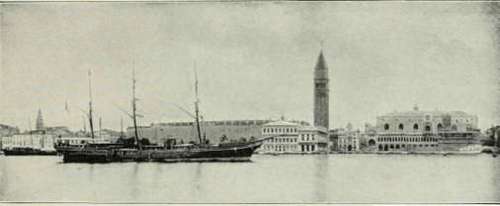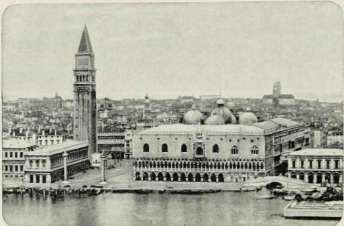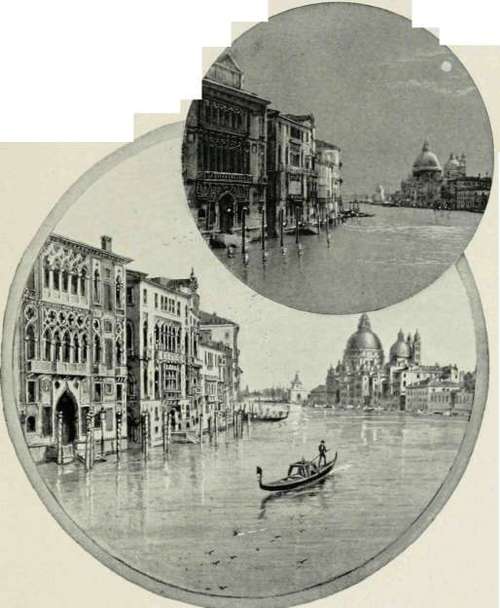Venice.
The City Of Silence.

Venice By Moonlight.
The form of the Grand Canal is that of a huge letter "S." Whenever it is looked upon from an elevation, this "S" is suggestive of the Italian word Silenzio, for Venice is pre-eminently the City of Silence. No roar of wheels disturbs one here; no strident gongs; no tramp of horses'

On The Grand Canal.

The Rialto.
feet. Reclining on the cushions of a gondola, one floats in absolute tranquillity upon a noiseless sea.
To go to another city after Venice is like removing from one's ears the fingers which for a little time had closed them to all sounds. No place is better for a weary brain-worker than Venice. His nerves relax in its restful stillness. The hand of Nature gently lifts the veil from his hot, wearied eyes; and he perceives at last that when a comfortable livelihood has been secured, to keep on toiling feverishly in the modern world, beneath a pall of soot and in the midst of noisy, heartless crowds, is not to live: it is merely preparing to die.

A Familiar Scene.
Upon a moonlit night these liquid corridors present a scene too beautiful for words. It is the Venice of one's dreams. According to the light or shade, we glide through alternating paths of glory and of gloom. All the defects which day reveals are, by moonlight, totally concealed or softened into indistinctness, like features hidden by a silvery veil. Here and there some lights are gleaming through the casements; but, as a rule, the city seems to sleep.
Occasionally, it may be, a boat full of musicians will appear, and, to the passionate throbbing of the harp or guitar, a score of voices chant the songs of Italy. Meanwhile, a dozen gondolas, with listening occupants, float in the shadows of the marble palaces. These, when the music ceases, approach the expectant singers, and silver coins fall into outstretched hands, which glisten phantom-like for a moment in the moonlight. Then each gondola, with swan-like grace, in silence disappears, leaving behind it a long furrow like a chain of gold.
When the visitor to Venice prepares to leave for a time his gondola, there is no need to say where he will land. There is one little area more important than all others, which every tourist longs to see and explore. It is a perfectly familiar scene, yet I have often noticed, with a thrill of sympathy, a tremor in the voice of the enthusiastic traveler who sees it for the first time, as he exclaims: "That building on the right is surely the Ducal Palace, and on the left is the entrance to the Piazzetta".
"That lofty tower is, of course, the Campanile. But where is St. Mark's?"
"It is just behind the Ducal Palace, and invisible from this point".
"And the famous Piazza?"
"That, too, is hidden behind the building on the left, but it is at right angles with the Piazzetta, and lies within the shadow of the Campanile".
As one draws nearer to the spot, how marvelously beautiful it all appears! Now one begins to appreciate the splendor of the Doge's Palace. Above it, like a constellation rising from the sea, glitter the domes of the Cathedral of San Marco. Presently the long landing-pier and the attractive Piazzetta are distinctly visible; and, turning one's astonished vision heavenward, one looks with admiration on the splendid bell-tower, three hundred and fifty feet in height, its pointed summit piercing the light clouds and its aerial balcony hung like a gilded cage against the sky. The traveler who beholds these scenes may have had many delightful moments in his life, but that in which he looks for the first time upon this glorious combination of the historic and the beautiful can hardly be surpassed. Like the names of the old nobles, it should be written in a "Book of Gold".

The Heart Of Venice.
On the border of the Piazzetta are two stately columns. On landing, therefore, one naturally gives to them one's first attention. It is difficult to realize that these granite monoliths have been standing here for more than seven hundred years, but such is the fact, as they were erected in the year 1187. They were a portion of the spoils brought back by the Venetians from the treasure-laden East. Each upholds the emblem of a patron saint: one, a statue of St. Theodore; the other, the famous winged lion of St. Mark.

ليست هناك تعليقات:
إرسال تعليق